Introduction
As we enter 2020, the Stanford Institute for Human-Centered Artificial Intelligence has published its Artificial Intelligence Index – 2019 Report. The AI Index originated as part of a century-long Stanford study of AI’s progress and impact.
The AI Index report examines in a very detailed manner the biggest trends shaping the AI industry, breakthrough research, and AI’s impact to society. It also gives us a great picture of AI hiring and investments, AI research contributions by nation, how much AI plays a role in specific industries, and much more.
I believe that this is a very high-value report and you can use it as a starting point for informed conversations about AI.
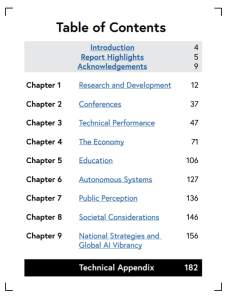
As you can notice from its table of contents in the snapshot above, it is quite an extensive read! But don’t worry! Given the value at stake, I decided to come to rescue — in this blogpost I have put together the major highlights from the various sections of the report for you. Let’s look together what is the current state of the AI world.
1. Research and Development
- Between 1998 and 2018, the volume of peer-reviewed AI papers has grown by more than 300%, accounting for 3% of peer-reviewed journal publications and 9% of published conference papers.
- In 2018, Chinese government institutions produced nearly three times more AI papers than Chinese corporations. China has also seen a 300-fold increase in government-affiliated AI papers since 1998. On the other hand, in the US., a relatively large proportion of AI papers are affiliated with corporations. In 2018, the number of corporate-affiliated AI papers in the US was over seven times the proportion of corporate AI papers in China, and almost twice that of Europe.
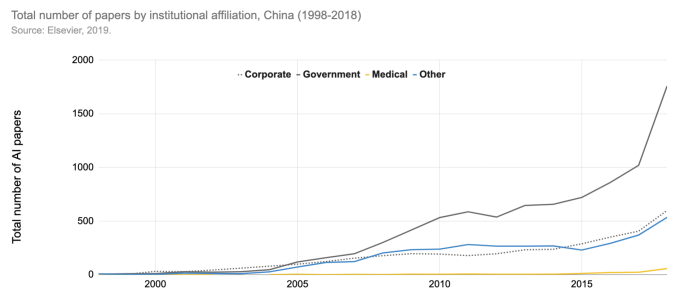

- Another interesting trend is the emergence of corporate-backed research frameworks, like Tensorflow (Google) and PyTorch (Facebook).
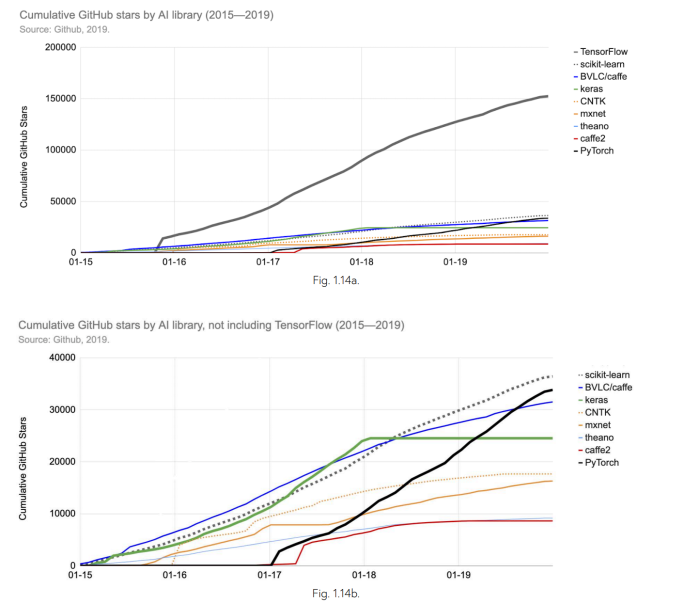
- Many Western European countries, especially the Netherlands and Denmark, as well as Argentina, Canada, and Iran show relatively high presence of women in AI research.
2. Conferences
- Attendance at AI conferences continues to increase significantly.

- China had the largest number of submitted and accepted papers at AAAI – one of the longest running AI conferences.

- The WiML workshop has eight times more participants than it had in 2014 and AI4ALL has 20 times more alumni than it had in 2015. These increases reflect a continued effort to include women and underrepresented groups in the AI field.
3. Technical Performance
- In a year and a half, the time required to train a large image classification system on cloud infrastructure has fallen from about three hours in October 2017 to about 88 seconds in July, 2019! During the same period, the cost to train such a system has fallen similarly.

- In 2019 two new achievements were added to the “Human-level Performance Milestones“:

4. Economy
- Singapore, Brazil, Australia, Canada and India experienced the fastest growth in AI hiring from 2015 to 2019.
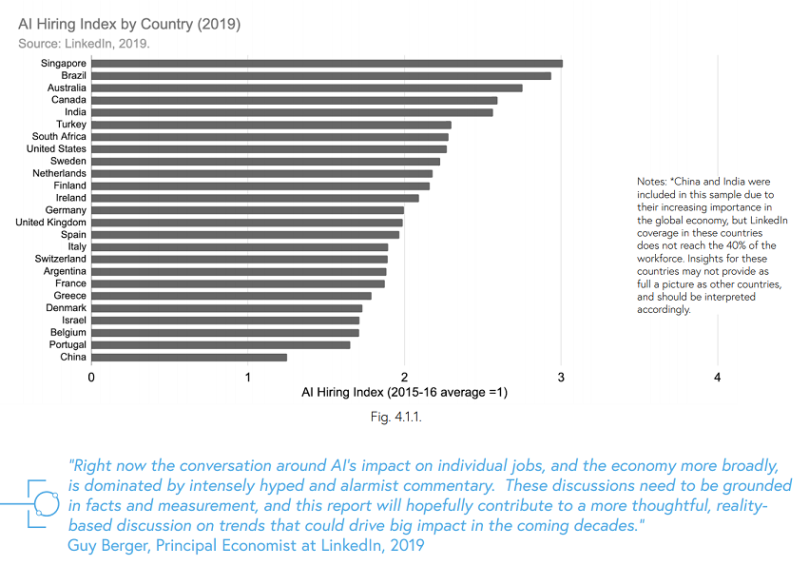
- In the US, the share of jobs in AI-related topics increased from 0.26% of total jobs posted in 2010 to 1.32% in October 2019. The state of Washington has the highest relative AI labor demand. And Machine Learning jobs have the highest demand.

- Globally, 4,403 AI-related companies were identified that received investment during the last year. From 36 distinct sectors, top focus areas included Data Tools (5.5% of all companies); Fashion and Retail Tech (4.7); Industrial Automation, Oil& Gas (4.3%); Financial Tech (4.2%); and Text Analytics (4.2%). During that time period, these funded startups received a total of $55.7B in private investment, or roughly $12.6M per startup.

- Autonomous Vehicles (AVs) received the largest share of global investment over the last year with $7.7B (9.9% of the total), followed by Drug, Cancer and Therapy ($4.7B, 6.1%), Facial Recognition ($4.7B, 6.0%), Video Content ($3.6B, 4.5%), and Fraud Detection and Finance ($3.1B, 3.9%).
- 58% of large companies surveyed report adopting AI in at least one function or business unit in 2019, up from 47% in 2018.
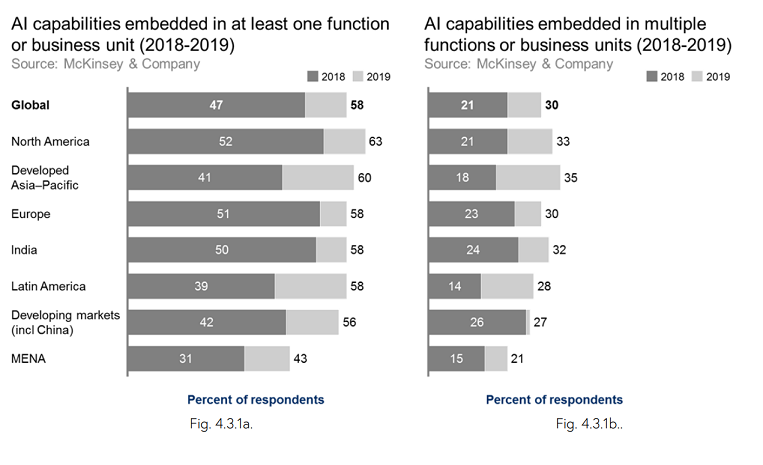
- Despite growing recognition of the importance of addressing ethical concerns associated with usage of AI, only 19 percent of respondents say their organizations are taking steps to mitigate risks associated with explainability of their algorithms, and 13 percent are mitigating risks to equity and fairness, such as algorithmic bias and discrimination.
5. Education
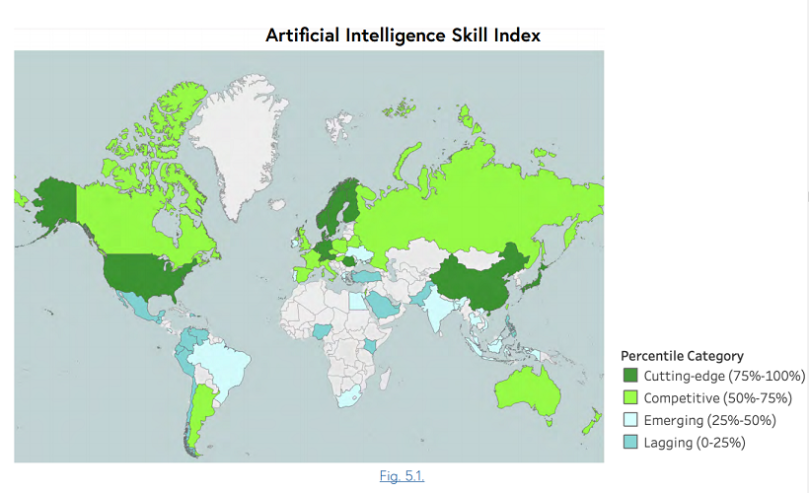
- Enrollment continues to grow rapidly in AI and related subjects. At the graduate level, AI has rapidly become the most popular specialization among computer science PhD students in North America.
- Industry has become, by far, the largest consumer of AI talent. In 2018, over twice as many AI PhD graduates went to industry as took academic jobs in the US. Also, AI faculty leaving academia for industry continues to accelerate, with over 40 departures in 2018.
- Diversifying AI faculty along gender lines has not shown great progress. And between 2010 and 2018, the percent of female AI PhD recipients has also remained stable at around 20%.
6. Autonomous Systems
- Autonomous Vehicles (AVs) are one of the most visible and potentially disruptive applications of AI. There are prototypes currently being tested around the world. There are at least 25 countries with cities that are testing AV’s, with Nordic countries and the Netherlands making big strides in deploying electric vehicles (EV) charging stations and in using AV’s for logistic supply chain management, and Singapore having designated test areas in the metropolis for AV’s.

- The total number of miles driven and total number of companies testing AVs in California has grown over seven-fold between 2015-2018. In 2018, the State of California licensed testing for over 50 companies and more than 500 AVs, which drove over 2 million miles.
- At least 89 countries have automatic air defense systems in their arsenal.
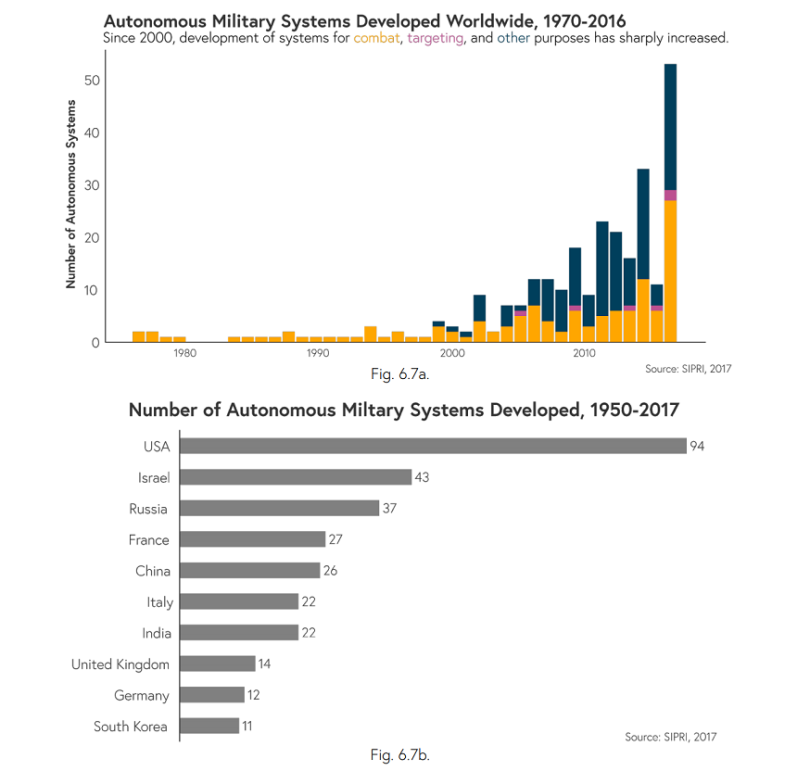
7. Public Perception
- Global central bank communications demonstrate a keen interest in AI, especially from the Bank of England, Bank of Japan, and the Federal Reserve.
- There is a significant increase in AI related legislation in congressional records, committee reports, and legislative transcripts around the world.
- The share of earning calls where AI is mentioned has increased substantially. Among sectors, finance has the largest number of AI mentions in earnings calls from 2018 to Q1 of 2019, followed by the electronic technology, producer manufacturing, healthcare technology, and technology services sectors.
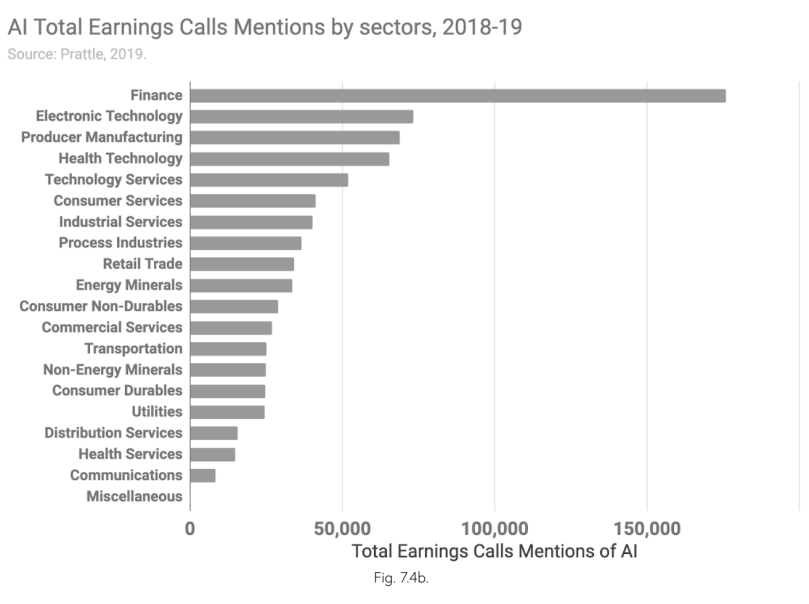
8. Societal Considerations
- Fairness, Interpretability and Explainability are identified as the most frequently mentioned ethical challenges.

- In over 3600 global news articles on ethics and AI identified between mid-2018 and mid-2019, the dominant topics are framework and guidelines on the ethical use of AI, data privacy, the use of face recognition, algorithm bias and the role of big tech.
- Countries differ significantly with respect to which AI ethical issues (as defined by Harvard here) they give most news coverage. While media sources based in the US or UK had more balanced coverage between categories, others reflected specific focus areas. In Switzerland, for example, 45% of all articles covered guidelines and frameworks on AI development, while 44% of Chinese news focused on safety and security, and 48% of articles in Singaporean sources explored transparency and explainability.

- AI can contribute to each of the 17 United Nations (UN) Sustainable Development Goals (SDGs) — the UN SDGs are a collection of 17 global goals set by the United Nations for the year 2030, for poverty alleviation, improving health and education, reducing inequality, preserving the environment, and boosting economic growth, amongst other priorities — but bottlenecks still need to be overcome to deploy AI for sustainable development at scale.
9. National Strategies and Global AI Vibrancy
- The number of official AI strategy documents (both global and national reports) has been increasing over the last few years, and countries are developing new strategies constantly.

Great Resources
The AI Index 2019 Report provides two very interesting and highly valuable resources as supplement:
- The raw data underlying the report and all the graphics! You can find it on Google Drive.
- Global AI Vibrancy Tool – an interactive tool that compares countries across 34 indicators, including both a cross-country perspective and an intra-country drill down.
Conclusion
Hope you found this summary helpful. Now that you have a good overall picture, I advise you to dig deeper into the sections that are most relevant for you. Do check out the Global Vibrancy tool and see how your country is doing in the AI world.
. . .
 If you liked this article, follow this blog to get updates about new posts. Also, help me reach out to the readers who can actually benefit from this by sharing this article with them. Thanks and Happy Learning!
If you liked this article, follow this blog to get updates about new posts. Also, help me reach out to the readers who can actually benefit from this by sharing this article with them. Thanks and Happy Learning! 
P.S. Have a wonderful year and decade ahead!

